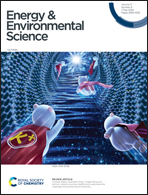Metal shields with crystallographic discrepancies incorporated into integrated architectures for stable lithium metal batteries†
Abstract
3D-structured hosts can play a significant role in improving the stability of metal-based rechargeable batteries with high-energy density, such as lithium metal batteries (LMBs). Nevertheless, the equipotential nature of the host leads to Li accumulation on the top surface rather than on the inside surface, which degrades Li storage efficiency. Herein, we report metal shields with crystallographic discrepancies to block the surface deposition of Li. Among various metals, titanium (Ti) is revealed to provide a high barrier for Li nucleation based on its hexagonal close-packed crystal structure that is greatly different from the body-centered cubic structure of elemental Li, leading to strong lithiophobicity. Ti exhibits an excellent ability to inhibit Li deposition, confining Li to sites on Ti-free surfaces. Confined Li deposition can be realized with high selectivity up to a current density of 10 mA cm−2, which suggests that metal shields could be used to resolve difficulties associated with the top-surface accumulation of Li. To demonstrate the feasibility of this approach, a facile top-down approach is first developed to fabricate an integrated architecture through wet-etching chemistry. The results show that Li can be stably accommodated inside the developed integrated architectures while avoiding surface Li deposition, leading to enhanced stability in anode-free LMBs.



 Please wait while we load your content...
Please wait while we load your content...